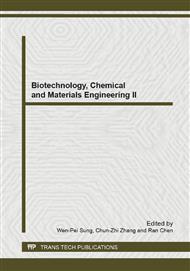[1]
Lan Wang, Guangbiao Zhou, Ping Liu, Jun-Hong Song, Yang Liang, Xiao-Jing Yan, Fang Xu, Bing-Shun Wang, Jianhua Mao, Zhixiang Shen, Saijuan Chen, and Zhu Chen. Dissection of mechanisms of Chinese medicinal formula Realgar-Indigo naturalis as an effective treatment for promyelocytic leukemia. PNAS, (2007).
DOI: 10.1073/pnas.0712365105
Google Scholar
[2]
Vivian Hsiu-Chuan Liao, Yu-Ju Chu, Yu-Chen Su, Sung-Yun Hsiao, Chia-Cheng Wei, Chen-Wuing Liu a, Chung-Min Liao a, Wei-Chiang Shen b, Fi-John Chang. Arsenite-oxidizing and arsenate-reducing bacteria associated with arsenic-rich groundwater in Taiwan Journal of Contaminant Hydrology. (2010).
DOI: 10.1016/j.jconhyd.2010.12.003
Google Scholar
[3]
Yu Yang, Min-xi Wan, Wu-yang Shi, Hong Peng, Guan-zhou Qiu, Ji-zhong Zhou, Xue-duan Liu, Bacterial diversity and community structure in acid mine drainage from Dabaoshan Mine, China, AQUATIC MICROBIAL ECOLOGY Aquat Microb Ecol 47 (2007) 141-151.
DOI: 10.3354/ame047141
Google Scholar
[4]
Wang zhengang, hehaiyan, yanyulun, wuchuanye, yangyun, gaoxueying. the research for residents exposed to arsenic at Shimen realgar ore area. JOURNAL OF HYGIENE RESEARCH, 28(1999).
Google Scholar
[5]
U K Chowdhury, B K Biswas, T R Chowdhury, G Samanta, B K Mandal, G C Basu, C R Chanda, D Lodh, K C Saha, S K Mukherjee, S Roy, S Kabir, Q Quamruzzaman, and D Chakraborti. Groundwater arsenic contamination in Bangladesh and West Bengal, India. Environ Health Perspect, 108 (2000).
DOI: 10.1289/ehp.00108393
Google Scholar
[6]
Sun, G. Arsenic contamination and arsenic sis in China. Toxicol Appl Pharmacol, 198 (2004) 268-271.
Google Scholar
[7]
Yu Yang , Xiang Wang, Jiafu Shi , Jiangjiang Li. The influence of the discharging sewage on microbial diversityin sludge from Dongting Lake. World J Microbiol Biotechnol, 28 (2012) 421-430.
DOI: 10.1007/s11274-011-0831-2
Google Scholar
[8]
Tom C.J. Hill, Kerry A. Walsh, James A. Harris 1, Bruce F. Mo!ett. Using ecological diversity measures with bacterial communities. FEMS Microbiology Ecology, 43 (2003) 1-11.
DOI: 10.1111/j.1574-6941.2003.tb01040.x
Google Scholar
[9]
Young S. Do, Thomas M. Schmidt, James A. Zahn, Eric S. Role of Rhodobacter sp. Strain PS9, a Purple Non-Sulfur Photosynthetic Bacterium Isolated from an Anaerobic Swine Waste Lagoon, in Odor Remediation. APPLIED AND ENVIRONMENTAL MICROBIOLOGY, Mar. p. (2003).
DOI: 10.1128/aem.69.3.1710-1720.2003
Google Scholar
[10]
Michael T. Madigan, Deborah O. Jung, Carl R. Woese, Laurie A. Achenbach. Rhodoferax antarcticus sp. nov., a moderately psychrophilic purple nonsulfur bacterium isolated from an Antarctic microbial mat. Arch Microbiol, 173(2000) 269–277.
DOI: 10.1007/s002030000140
Google Scholar
[11]
Joanne M. Santini, Rachel N. vanden Hoven. Molybdenum-Containing Arsenite Oxidase of the Chemolithoautotrophic Arsenite Oxidizer NT-26. Journal of Bacteriology, (2004)1614-1619.
DOI: 10.1128/jb.186.6.1614-1619.2004
Google Scholar
[12]
P. D. FRANZMANN, V. B. D. SKERMAN, Agitococcus lubricus gen. nov. sp. nov., a Lipolytic, Twitching Coccus from Freshwater. International Journal of Systematic Bacteriologyijs sgmjournals, 31 (1981) 177-183.
DOI: 10.1099/00207713-31-2-177
Google Scholar
[13]
Rachel N. vanden Hoven, Joanne M. Santini. Arsenite oxidation by the heterotroph Hydrogenophaga sp. str. NT-14: the arsenite oxidase and its physiological electron acceptor. Biochimica et Biophysica Acta 1656 (2004) 148-155.
DOI: 10.1016/j.bbabio.2004.03.001
Google Scholar
[14]
J.M. Santini, L.I. Sly, A. Wen, D. Comrie, P. De Wulf-Durand, J.M. Macy. New arsenite-oxidizing bacteria isolated from Australian goldmining environments phylogenetic relationships. Geomicrobiol, 19 (2002) 67-76.
DOI: 10.1080/014904502317246174
Google Scholar
[15]
Kim.Y., Kim J.W., Ha.C.Y., Lee H.W., Ha.J.S., Park H.W., Lee J.W., Park Y.K. and Kwon S.Y. Comparison of Perchloroethylene (PCE) Dechlorination Activities by Performing Microcosm Tests Using Groundwater from Four Different PCE-contaminated Aquifers in Korea. (2004).
Google Scholar
[16]
Yarza,P., Euzeby,J., Sproeer,C., Klenk H.P. and Crouch,A. Taxonomic note: SOS, Sequencing Orphan Species: filling the gaps in the 16S rRNA gene sequence database for all classified species with validly published names. (2011).
Google Scholar
[17]
Anisimova LA, Siunova TV, Boronin AM. Metal resistance of gram-negative bacteria isolated from soil and waste waters of industrial regions. Mikrobiologiia, 62(5) (1993) 843-847.
Google Scholar
[18]
Magurran E. Ecological diversity and its measurement. Princeton University Press, Princeton, NJ (1988).
Google Scholar
[19]
Zhou JZ, Xia BC, Treves DS, Wu LY, Marsh TL, O'Neill RV, Palumbo AV, Tiedje JM. Spatial and resource factors influencing high microbial diversity in soil. Appl Environ Microbiol, 68(2002) 32.
DOI: 10.1128/aem.68.1.326-334.2002
Google Scholar
[20]
Stach JEM, Maldonado LA, Masson DG, Ward AC, Goodfellow M, Bull AT. Statistical approaches for estimating actinobacterial diverity in marine sediments. Appl Environ Microbiol, 69(2003) 6189-6200.
DOI: 10.1128/aem.69.10.6189-6200.2003
Google Scholar
[21]
Bruce F. Moffett, Fiona A. Nicholson, Nnanna C. UWakwe, Brian J. Chamber, James A. Harris, Tom C.J. Hill. Zink contamination decreases the bacterial diversity of agricultural soil. FEMS Microbiology Ecology, 43 (2003) 13-19.
DOI: 10.1111/j.1574-6941.2003.tb01041.x
Google Scholar


